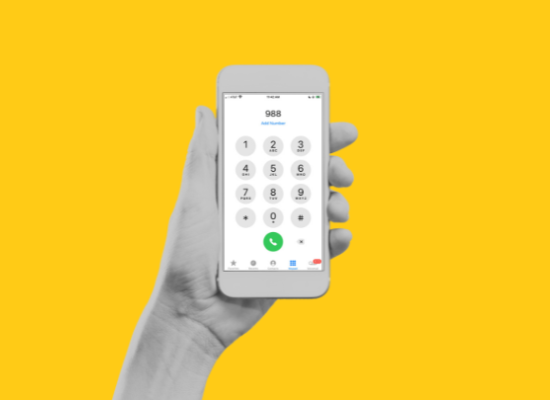
Stephanie Hepburn is a writer in New Orleans. She is the editor in chief of #CrisisTalk. You can reach her at .
States across the nation are scrambling to develop or strengthen their crisis care systems before 988—the nationwide three-digit number for behavioral health emergencies—becomes a reality on July 16, 2022. Kirsten Beronio, JD, Policy and Regulatory Affairs director at the National Association for Behavioral Healthcare, says states can, at least in part, draw upon several existing CMS initiatives.
Until February 2020, Beronio was the senior policy advisor for Behavioral Health Care at the Center for Medicaid and CHIP Services. She worked on CMS initiatives that could very well provide funding streams for crisis stabilization services, helping to address the needs of 988 callers. One such opportunity is within the pages of a November 2018 letter from the agency to state Medicaid directors titled “Opportunities to Design Innovative Service Delivery Systems for Adults with a Serious Mental Illness or Children with a Serious Emotional Disturbance” (SMD # 18–011). It includes demonstration opportunities and strategies to support innovative behavioral health delivery systems for SMI and SED populations called for by the 21st Century Cures Act, section 12003.
“The statute and direction,” says Beronio, “allowed CMS to build on work we’d been doing with state Medicaid agencies to address substance use disorder services.”
Substance Use Disorder and Mental Health Initiatives
In 2015, CMS developed a parity-driven substance use disorder treatment initiative that, in part, was a response to the Affordable Care Act. The agency expected there would be new mainstream SUD treatment coverage, including by Medicaid for low-income childless adult beneficiaries at risk for SUDs.
Two years later, CMS streamlined the initiative to increase funding opportunities for states struggling with the opioid crisis. It allowed states to receive Medicaid matching payments for services provided to beneficiaries staying in residential treatment facilities and improved Medicaid beneficiaries’ access to other levels of treatment for SUDs.
Funding through that initiative comes with a number of requirements, including that states mandate residential treatment providers to offer medication-assisted treatment in those settings.
With the passing of the Cures Act in 2016, CMS added a new initiative to the SUD model, offering states an opportunity to expand and improve access to care for SMI and SED populations enrolled in Medicaid. It focused on earlier identification and engagement, mental health and primary care integration, and improved treatment access. As part of the application process, CMS asks states to include a thorough assessment of their existing provider landscape, including gaps and crisis stabilization services.
“We wanted states to think more broadly about the care a person might need,” says Beronio, “including crisis stabilization services.”
She says the idea was to shift how states approach services and coverage, getting them away from thinking, “If we just had coverage for IMD [institutions for mental diseases] services, it would solve all of our problems.” Instead, CMS wanted states to step back and examine how they could improve the entire behavioral health system. Yes, says Beronio, some people will need inpatient treatment, but that’s only one part of the services people in crisis may need. “They might instead just need something more like an urgent care clinic with rapid provider access.”
That’s why the SMI-SED initiative connected the waiver for IMD services to state action: to improve people’s access to comprehensive crisis care and broaden efforts to increase integration, earlier engagement in treatment, and improve discharge planning practices from inpatient care. “We were trying to ensure that states were thinking about ways to address the needs of people along a continuum,” says Beronio.
1115 Medicaid Demonstration Waivers
The SMI-SED initiative letter also addressed feedback from states that the Institutions for Mental Diseases Exclusion creates a barrier to care and system inefficiencies. The long-standing exclusionary rule is a provision in Title 19 of the Social Security Act that established Medicaid, which states that federal reimbursement is not available for “institution for mental diseases” services. The act defines an IMD as a specialized mental health or substance use disorder facility or setting with over 16 beds.
Over the years, Section 1115 Medicaid demonstration waivers have been one workaround to IMD exclusions, granting the secretary of Health and Human Services (and CMS by delegation) authority to waive specific Medicaid law provisions. The idea behind the waivers, notes Beronio, was to allow states to come up with and offer innovative ways to provide care for their Medicaid beneficiaries. But it wasn’t always an efficient process.
One challenge is that the policy for when section 1115 waivers may be authorized depends on the administration in office, with some administrations pulling back or implementing different policies. The other issue is that the statutory waiver language is quite broad.
“States would come in with an idea, and CMS would have to ruminate on it for a long time,” says Beronio. “There was often a lot of back and forth, uncertainty, and negotiation between the two.”
In 2015, the SUD-focused section 1115 initiative presented states another opportunity to access federal funding for excluded services. When the agency revised it in 2017, it made it more explicit to states, says Beronio, what they needed to do to qualify. The agency designed the revisions to make it easier to navigate, letting states know what they needed to do and what the initiative covered. It was also more flexible.
“CMS allowed states to do some of that innovative work after their demonstration was approved instead of requiring them to make a lot of changes before receiving approval of their demonstration,” says Beronio.
At the same time, states were required to report more information and at more regular intervals on their progress implementing those changes. The revision made the initiative more streamlined, transparent, flexible, and standardized.
The Full Continuum and Crisis Care Standardization
When CMS put together the SMI-SED focused initiative, they incorporated core principles from the 2017 SUD initiative revisions. Beronio notes that the standardization element was a significant shift as, historically, 1115 demonstrations greatly varied state by state.
The 2018 SMI-SED letter to state Medicaid directors also included an expectation: while CMS would use its 1115 demonstration authority to allow for coverage of excluded services, states had to consider the full continuum of services people need, including crisis stabilization services.
The letter describes the demonstration’s goals and milestones (pages 14-17), reforms CMS requires states to address as part of these demonstrations. Among the goals listed are reducing emergency room psychiatric boarding and hospital readmissions, improving community-based care and care coordination, especially the continuity of care after a hospitalization or residential treatment facility stay, and improving crisis stabilization services. The latter includes call centers, mobile crisis teams, intensive outpatient services, and acute short-term crisis stabilization.
The agency also carefully defined the milestones, with specific steps states must take to address the following topics:
- Ensuring quality of care in psychiatric hospitals and residential settings,
- Improving care coordination and transitions to community-based care,
- Increasing access to a continuum of care, including crisis stabilization services, and
- Earlier identification and engagement in treatment, including through increased integration.
CMS also expects states to commit to a financing plan to increase the availability of crisis stabilization services and broader community-based services. “Again, we were trying to nudge states to think about the big picture,” Beronio says. “Where can people turn outside of the emergency department? How can they develop a coordinated community-based crisis response and integrated services?”
Connecting the Dots: Assessment and Funding Opportunities
Today, Beronio is the Policy and Regulatory Affairs director at the National Association for Behavioral Healthcare, a non-profit that represents many provider systems throughout the United States. Among its members are organizations that run call centers and other crisis services such as in-home stabilization or psychiatric urgent care walk-in clinics as well as psychiatric hospitals, residential treatment centers, partial hospitalization and intensive outpatient programs, and medication-assisted treatment centers. She says the implementation of 988 is an opportunity for communities to improve both behavioral healthcare coordination and access, beginning with an integrated call center.
“It starts with a call center that doesn’t just answer calls but is close enough to the provider community to know what’s available in the caller’s area,” she says.
It’s also essential that states clearly understand what resources they have and those they don’t. States applying for the SMI-SED demonstration must complete a full assessment of the treatment providers in the state. It’s not just about listing them out, notes Beronio, but also tracking their capacity, availability, and the levels of care they provide. “It’s a baseline that states must continuously update,” she says. “And it’s how, through call centers, a community can build its most immediate crisis response.”
With 988 on the horizon, more states may apply for applicable 1115 demonstrations. So far, CMS has approved seven states to take part in the SMI-SED demonstration initiative, with another handful in the approval process. Those who’ve applied, notes Beronio, will have a stronger 988 foundation. “They’ve done the assessment, which will give them a clear diagnostic for where they are and where they need to go in terms of crisis care,” she says.
States can also use existing Medicaid authorities to build their crisis care infrastructure for 988. For example, pages seven and eight of the CMS letter to state Medicaid directors on the SMI-SED initiative highlight that Medicaid can fund crisis stabilization programs without a section 1115 demonstration. Even crisis call centers. “There’s an opportunity for Medicaid to provide an administrative match for the federal costs of setting up and operating a crisis call center,” says Beronio. There’s also the opportunity for an enhanced match for those same activities, a 90% and 75% match, respectively, if the state can make the case that it’s using information technology to develop and operate the call center service.
Both the SUD and SMI-SED demonstrations will be available as long as the Biden administration continues them. States can also seek concurrent approval of an SMI-SED and SUD demonstration.
There’s no deadline to apply, but a demonstration request must come through the state’s Medicaid agency. It has to reach out to CMS and then work with the agency to develop a proposal and negotiate an agreement.
The SMI-SED demonstration process takes a fair amount of time and state resources. So it comes with associated administrative costs for implementing Medicaid changes. That can weigh heavily on any state during the best of times, no less amidst a global pandemic that’s hacked away at state budgets and spiked call center demand. “Just having the resources to do this work right now might challenge states as staff are stretched thin,” says Beronio.
She says what would be useful is guidance for state Medicaid agencies regarding the new 988 and crisis stabilization services opportunity, sharing the Medicaid authorities they can tap into, including administrative match opportunities to help establish and run a call center. “CMS touched on this in the 2018 letter, but additional information on these points could be helpful,” she says.
Also, for states that don’t want to do an 1115 demonstration, CMS could develop a state plan amendment template outlining Medicaid authorities that can be used to cover services provided to people experiencing behavioral health crises, such as diagnostic services, rehabilitative services, physicians’ services, other licensed practitioner services, and clinic services.
Also, states can turn to other demonstrations for their 988 infrastructure, like the Certified Community Behavioral Health Clinic demonstration, which has an enhanced federal match, to fund crisis stabilization services.
It’s challenging for states and communities to connect the dots between all existing funding streams, Medicaid and otherwise. Beronio says states will need both seed money through federal grants and sustainability through Medicaid, Medicare, and private commercial insurers, and possibly wireless user fees (as authorized to states by the National Suicide Hotline Designation Act of 2020). She points out that Medicaid, with a few exceptions, is not readily accessible for the upfront costs states need right now.
“We’re going to need more flexible funding for states through grants to catalyze these activities, and then look to Medicaid and other healthcare coverage programs and insurers to fund some of these services on an ongoing basis for their enrollees,” she says.
Building a robust 988 system will require an all-payer approach to pay for crisis services, including not just Medicaid but also private commercial insurers and Medicare. Regarding Medicare, Beronio says programs like ET3—which stands for Emergency Triage, Treat, and Transport—may point to ways Medicare can be engaged in new crisis response programs. The five-year payment model allows ambulance services to divert lower-acuity psychiatric crises to facilities that better match the person’s needs instead of defaulting to a nearby hospital emergency department.
Shifting 988 Language from Suicide and Mental Health to Behavioral Health
When it comes to engaging commercial payers and states in 988 discussions, Beronio says language matters. Over the past few years, payers have increasingly recognized that behavioral health populations drive their costs. “It’s a growing recognition that has percolated upward through the leadership levels.” However, 988 came out of the National Suicide Hotline Improvement Act, and legislators and experts alike have talked about it as mirroring 911 for suicide crisis with less mention of broader mental health and substance use disorders. “That makes it sound like it’s only for people contemplating suicide,” says Beronio.
In reality, the three-digit number has a far broader application and can be the front door for people experiencing any mental health or substance use crisis. It could match people to immediate and appropriate care and divert them from the emergency department and the criminal justice system.
“988 has the potential to be a game-changer,” says Beronio, “and if we talk about it as a behavioral health crisis line, then states and commercial payers are more likely to see it as offering concrete opportunities to make improvements on a broader set of behavioral health issues that they’ve been struggling to address.”









